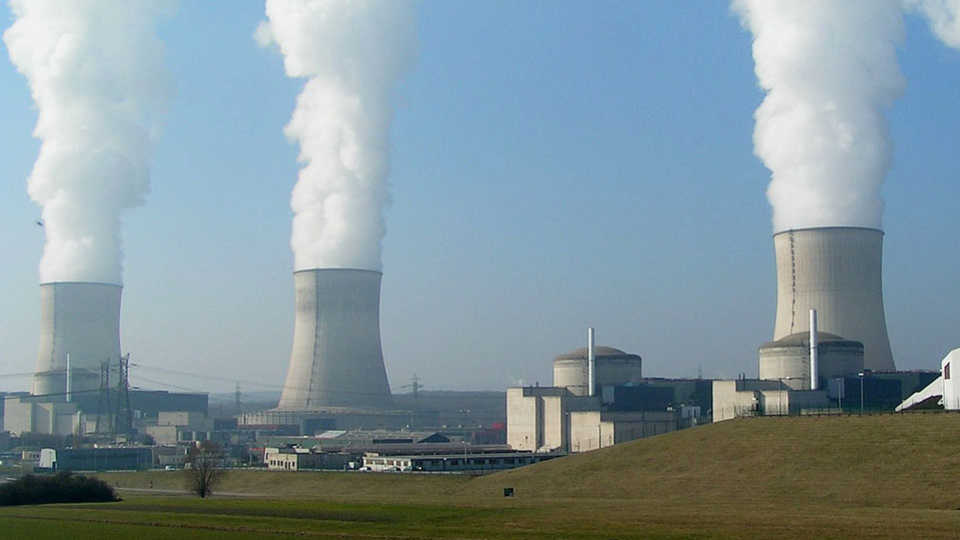Students will be able to:
- describe at least two problems with burning fossil fuels.
- recommend solutions for reducing use of fossil fuels.

"Nuclear Power Plant Cattenom" © 2005 Stefan Kühn
In these two activities, students will explore two consequences of burning fossil fuels: air pollution and the greenhouse effect. For a comprehensive unit on fossil fuels, this lesson works especially well as an extension to Fossil Fuels: Chocolate Chip Mining.
Students will be able to:
The Greenhouse Effect
Air Pollution
This experiment has a tendency to not show intended results if the steps are not followed precisely. For this reason, we recommend doing it once beforehand, without students, to familiarize yourself with the setup and be sure all the pieces are working. If you are not seeing the temperature in Beaker 2 rising faster than that in Beaker 1, try the troubleshooting tips below.
Teacher Tip: Make this a group effort by having different students help with each step, including observing and recording temperatures.
Fossil Fuels
Fossil fuels like coal, oil, and natural gas present environmental problems starting with their extraction and going all the way through to their use. They are all different in their properties and uses, but they have some similarities. Fossil fuels all come from fossilized plant or animal material and are all nonrenewable resources; they take millions of years to form and do not regenerate on the timescale of a human life. All fossil fuels go through similar processes on their path from being extracted from the ground to serving as fuels for human beings.
We use fossil fuels for most of our energy needs today. Coal, natural gas, and oil accounted for 87 percent of global primary energy consumption in 2012, and they meet 82% of U.S. energy demand (Worldwatch Institute, 2013; Institute for Energy Research, 2014).
Greenhouse Gases
While greenhouse gases have received a lot of negative attention lately, it is also necessary to understand their importance. The earth has a layer of naturally occurring gases around the planet, including carbon dioxide (CO2), methane (CH4), and nitrous oxide (N2O) (EPA 2015). Much like a greenhouse for plants, these gases trap the sun’s heat around our planet making it warm enough to survive – indeed, we would not survive without them.
However, as fossil fuels burn, they release more greenhouse gases into the atmosphere. They absorb energy, slowing or preventing the loss of heat to space. In this way, they act like a blanket, making Earth warmer than it would otherwise be. Most of the observed global warming since the mid-20th century is due to human-caused greenhouse gas emissions (USEPA, 2014).
Some of the potential effects of global climate change will be an increase in wildfires, longer periods of drought, and an increase in the duration and intensity of tropical storms. The rising temperature will also cause a rise in sea level due to the melting of glacial ice, which in turn will cause flooding in coastal areas. (NASA, 2014).
Air Pollution
Air pollutants are those substances added to the air by humans that have negative environmental and health consequences. Air pollutants include particulates (particles of solids in the air), sulfur oxides, nitrogen oxides, hydrocarbons, carbon monoxide, and more.
Each year in the United States, industrial operations emit nearly 100 million tons of pollutants into the air. These include pollutants that make breathing difficult, form urban smog, impair visibility, and attack ecosystems. Air pollutants result in both environmental problems like acid rain and human health concerns like emphysema, bronchitis, and asthma (USEPA, 2011).
For up to date Air Quality information, go to Airnow, a cross-agency U.S. Government Web site.
Energy Conservation
As global supplies of cheap fossil fuels steadily decline and fossil fuel related greenhouse gases accumulate in the atmosphere, energy conservation is becoming a critical topic of discussion. Climate change is an important reason for people to reduce their fossil fuel consumption via conservation, efficiency measures, and switching to renewable energy sources.
Some of these technologies include: wind energy, biomass energy, carbon capture and underground storage, methane capture and use, geothermal energy, energy-efficient buildings and solar energy. These technologies are explained in detail here.
Science and Engineering Practices
Disciplinary Core Ideas
Cross-Cutting Concepts
Related Performance Expectations